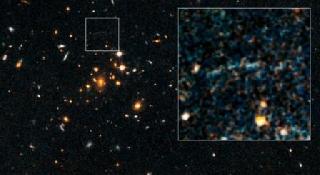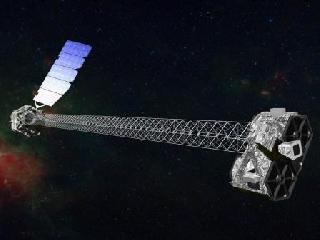
The images, taken by NASA's Hubble Space Telescope, show an arc of blue light behind an extremely massive cluster of galaxies residing 10 billion light-years away. Photo: NASA/ESA/University of Florida, Gainsville/University of Missouri-Kansas City/UC Davis.
PASADENA, CALIFORNIA (BNS): Astronomers using NASA's Hubble Space Telescope have found a puzzling arc of light behind an extremely massive cluster of galaxies residing 10 billion light-years away.
The galactic grouping, discovered by Spitzer Space Telescope, was observed as it existed when the universe was roughly a quarter of its current age of 13.7 billion years.
Dubbed IDCS J1426.5+3508, the cluster is the most massive found, weighing as much as 500 trillion suns. It is 5 to 10 times larger than other clusters found at such an early time in the history of the universe, NASA said.
Galaxy clusters are collections of hundreds to thousands of galaxies bound together by gravity. They are the most massive structures in the universe.
Astronomers frequently study galaxy clusters to look for faraway, magnified galaxies behind them that would otherwise be too dim to see with telescopes. Many such gravitationally lensed galaxies have been found behind galaxy clusters closer to Earth.
The team spotted the cluster in a search using NASA's Spitzer Space Telescope in combination with archival optical images taken as part of the National Optical Astronomy Observatory's Deep Wide Field Survey at the Kitt Peak National Observatory, Tucson, Arizona.
This unique system constitutes the most distant cluster known to "host" a giant gravitationally lensed arc. Finding this ancient gravitational arc may yield insight into how, during the first moments after the Big Bang, conditions were set up for the growth of hefty clusters in the early universe.
The arc was spotted in optical images of the cluster taken in 2010 by Hubble's Advanced Camera for Surveys. The infrared capabilities of Hubble's Wide Field Camera 3 helped provide a precise distance, confirming it to be one of the farthest clusters yet discovered.
"The chance of finding such a gigantic cluster so early in the universe was less than one percent in the small area we surveyed," said team member Mark Brodwin of the University of Missouri-Kansas City.
"It shares an evolutionary path with some of the most massive clusters we see today, including the Coma cluster and the recently discovered El Gordo cluster."
 Previous Article
Previous Article Next Article
Next Article











The Indian Air Force, in its flight trials evaluation report submitted before the Defence Ministry l..
view articleAn insight into the Medium Multi-Role Combat Aircraft competition...
view articleSky enthusiasts can now spot the International Space Station (ISS) commanded by Indian-American astr..
view article